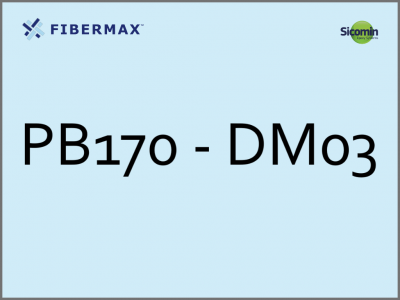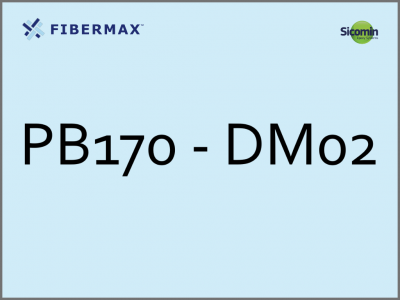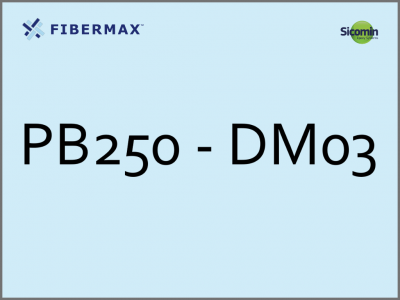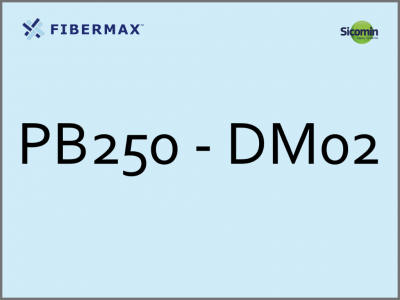1.00 kg set (0.76 kg resin + 0.24 kg hardener)
A system of 2 liquid components that when mixed, expands into cellular foam. After cure, it becomes very tough, and exhibits high performance, unique characteristics not possible to obtain by other expanding or liquid foams like polyurethane, polystyrene etc.
The PB170 / DM03 cellular foam production system expands and hardens to a final density of 170 kg / m3. The DM03 is the faster hardener.
Product description
The foaming products are 2 component systems (resin + hardener) developed for "in situ" low density foam production. They can be used to fill mold cavities, and avoid the use of low density fillers and/or the cost of machining of other readily expanded foams like PVC. They come white, but can be colored by adding any epoxy compatible pigment. The final density of the foam is a result of the choice of the resin. The PB170 resin provides approximately 170 kg/m3 foam. The hardener (in this case the DM03) influences only the curing time and not the potential thickness or final density of each shot (or layer) in the cast part.
The process can be separated in 2 steps:
step 1: The mixed resin+hardener expand rapidly into foam
step 2: The foam hardens slowly
Key features:
"In situ" and "in mold" manufacturing of low density foam core helps to avoid the use of low density fillers or CNC machining of expanded foams. Good adhesion onto all type of materials like prepregs and wet/dry epoxy, polyester and vinylester systems. Homogeneous density, floating volume, and very low water absorption. Can be used to increase the density of other cores and honeycomb. Foam blocks can be machined to produce models and prototypes.
Physical properties of resin PB170:
Color: White
Viscosity at 25 oC / 77 oF: 8000 (+-1500)
Density: 1.12 (+-0.01)
Physical properties of hardener DM03:
Color: Light yellow
Viscosity at 20 oC / 68 oF: 210 (+-40)
Density at 20 oC / 68 oF: 1.00 (+-0.01)
Mixing ratio: 31 hardener to 100 p.b.w. resin
Properties of cured system:
Final density after free expansion at 20 oC / 68 oF: 170 (+-20) kg / m3
Expansion ratio at 20 oC / 68 oF: X 6.2
Thermal stability after 24 hrs at room temperature + 6 hrs at 40 oC / 104 oF: Tg1 above 50 oC / 122 oF
Thermal stability after 24 hrs at room temperature + 12 hrs at 60 oC / 140 oF: Tg1 above 70 oC / 158 oF
Exothermic parameters: Are the thermal conductivity of substrate, open or closed mold, geometry and thickness, temperature of materials and mold, ambient temperature, volume and mass of the casting. When casting onto a thick laminate that is curing, the heat produced by the resin system can increase the reactivity of the foaming system.
Intrastat Number for this product: Epoxy: 39073000, Hardener: 38249098..
From 28.22€ ...to 38.56€
1.00 kg set (0.74 kg resin + 0.26 kg hardener)
A system of 2 liquid components that when mixed, expands into cellular foam. After cure, it becomes very tough, and exhibits high performance, unique characteristics not possible to obtain by other expanding or liquid foams like polyurethane, polystyrene etc.
The PB170 / DM02 cellular foam production system expands and hardens to a final density of 170 kg / m3. The DM02 is the slower hardener.
Product description
The foaming products are 2 component systems (resin + hardener) developed for "in situ" low density foam production. They can be used to fill mold cavities, and avoid the use of low density fillers and/or the cost of machining of other readily expanded foams like PVC. They come white, but can be colored by adding any epoxy compatible pigment. The final density of the foam is a result of the choice of the resin. The PB170 resin provides approximately 170 kg/m3 foam. The hardener (in this case the DM02) influences only the curing time and not the potential thickness or final density of each shot (or layer) in the cast part.
The process can be separated in 2 steps:
step 1: The mixed resin+hardener expand rapidly into foam
step 2: The foam hardens slowly
Key features:
"In situ" and "in mold" manufacturing of low density foam core helps to avoid the use of low density fillers or CNC machining of expanded foams. Good adhesion onto all type of materials like prepregs and wet/dry epoxy, polyester and vinylester systems. Homogeneous density, floating volume, and very low water absorption. Can be used to increase the density of other cores and honeycomb. Foam blocks can be machined to produce models and prototypes.
Physical properties of resin PB170:
Color: White
Viscosity at 25 oC / 77 oF: 8000 (+-1500)
Density: 1.12 (+-0.01)
Physical properties of hardener DM02:
Color: Clear to light yellow
Viscosity at 20 oC / 68 oF: 130 (+-25)
Density at 20 oC / 68 oF: 0.98 (+-0.01)
Mixing ratio: 36 hardener to 100 p.b.w. resin
Properties of cured system:
Final density after free expansion at 20 oC / 68 oF: 170 (+-20) kg / m3
Expansion ratio at 20 oC / 68 oF: X 6.2
Thermal stability after 24 hrs at room temperature + 6 hrs at 40 oC / 104 oF: Tg1 above 50 oC / 122 oF
Thermal stability after 24 hrs at room temperature + 12 hrs at 60 oC / 140 oF: Tg1 above 70 oC / 158 oF
Exothermic parameters: Are the thermal conductivity of substrate, open or closed mold, geometry and thickness, temperature of materials and mold, ambient temperature, volume and mass of the casting. When casting onto a thick laminate that is curing, the heat produced by the resin system can increase the reactivity of the foaming system.
Intrastat Number for this product: Epoxy: 39073000, Hardener: 38249098..
From 29.57€ ...to 39.17€
1.00 kg set (0.76 kg resin + 0.24 kg hardener)
A system of 2 liquid components that when mixed, expands into cellular foam. After cure, it becomes very tough, and exhibits high performance, unique characteristics not possible to obtain by other expanding or liquid foams like polyurethane, polystyrene etc.
The PB250 / DM03 cellular foam production system expands and hardens to a final density of 250 kg / m3. The DM03 is the faster hardener.
Product description
The foaming products are 2 component systems (resin + hardener) developed for "in situ" low density foam production. They can be used to fill mold cavities, and avoid the use of low density fillers and/or the cost of machining of other readily expanded foams like PVC. They come white, but can be colored by adding any epoxy compatible pigment. The final density of the foam is a result of the choice of the resin. The PB250 resin provides approximately 250 kg/m3 foam. The hardener (in this case the DM03) influences only the curing time and not the potential thickness or final density of each shot (or layer) in the cast part.
The process can be separated in 2 steps:
step 1: The mixed resin+hardener expand rapidly into foam
step 2: The foam hardens slowly
Key features:
"In situ" and "in mold" manufacturing of low density foam core helps to avoid the use of low density fillers or CNC machining of expanded foams. Good adhesion onto all type of materials like prepregs and wet/dry epoxy, polyester and vinylester systems. Homogeneous density, floating volume, and very low water absorption. Can be used to increase the density of other cores and honeycomb. Foam blocks can be machined to produce models and prototypes.
Physical properties of resin PB250:
Color: White
Viscosity at 25 oC / 77 oF: 12000 (+-2000)
Density: 1.10 (+-0.01)
Physical properties of hardener DM03:
Color: Light yellow
Viscosity at 20 oC / 68 oF: 210 (+-40)
Density at 20 oC / 68 oF: 1.00 (+-0.01)
Mixing ratio: 31 hardener to 100 p.b.w. resin
Properties of cured system:
Final density after free expansion at 20 oC / 68 oF: 250 (+-25) kg / m3
Expansion ratio at 20 oC / 68 oF: X 4
Thermal stability after 24 hrs at room temperature + 6 hrs at 40 oC / 104 oF: Tg1 above 50 oC / 122 oF
Thermal stability after 24 hrs at room temperature + 12 hrs at 60 oC / 140 oF: Tg1 above 70 oC / 158 oF
Exothermic parameters: Are the thermal conductivity of substrate, open or closed mold, geometry and thickness, temperature of materials and mold, ambient temperature, volume and mass of the casting. When casting onto a thick laminate that is curing, the heat produced by the resin system can increase the reactivity of the foaming system.
Intrastat Number for this product: Epoxy: 39073000, Hardener: 38249098..
From 26.37€ ...to 37.12€
1.00 kg set (0.74 kg resin + 0.26 kg hardener)
A system of 2 liquid components that when mixed, expands into cellular foam. After cure, it becomes very tough, and exhibits high performance, unique characteristics not possible to obtain by other expanding or liquid foams like polyurethane, polystyrene etc.
The PB250 / DM02 cellular foam production system expands and hardens to a final density of 250 kg / m3. The DM02 is the slower hardener.
Product description
The foaming products are 2 component systems (resin + hardener) developed for "in situ" low density foam production. They can be used to fill mold cavities, and avoid the use of low density fillers and/or the cost of machining of other readily expanded foams like PVC. They come white, but can be colored by adding any epoxy compatible pigment. The final density of the foam is a result of the choice of the resin. The PB250 resin provides approximately 250 kg/m3 foam. The hardener (in this case the DM02) influences only the curing time and not the potential thickness or final density of each shot (or layer) in the cast part.
The process can be separated in 2 steps:
step 1: The mixed resin+hardener expand rapidly into foam
step 2: The foam hardens slowly
Key features:
"In situ" and "in mold" manufacturing of low density foam core helps to avoid the use of low density fillers or CNC machining of expanded foams. Good adhesion onto all type of materials like prepregs and wet/dry epoxy, polyester and vinylester systems. Homogeneous density, floating volume, and very low water absorption. Can be used to increase the density of other cores and honeycomb. Foam blocks can be machined to produce models and prototypes.
Physical properties of resin PB250:
Color: White
Viscosity at 25 oC / 77 oF: 12000 (+-2000)
Density: 1.10 (+-0.01)
Physical properties of hardener DM02:
Color: Clear to light yellow
Viscosity at 20 oC / 68 oF: 130 (+-25)
Density at 20 oC / 68 oF: 0.98 (+-0.01)
Mixing ratio: 36 hardener to 100 p.b.w. resin
Properties of cured system:
Final density after free expansion at 20 oC / 68 oF: 250 (+-25) kg / m3
Expansion ratio at 20 oC / 68 oF: X 4
Thermal stability after 24 hrs at room temperature + 6 hrs at 40 oC / 104 oF: Tg1 above 50 oC / 122 oF
Thermal stability after 24 hrs at room temperature + 12 hrs at 60 oC / 140 oF: Tg1 above 70 oC / 158 oF
Exothermic parameters: Are the thermal conductivity of substrate, open or closed mold, geometry and thickness, temperature of materials and mold, ambient temperature, volume and mass of the casting. When casting onto a thick laminate that is curing, the heat produced by the resin system can increase the reactivity of the foaming system.
Intrastat Number for this product: Epoxy: 39073000, Hardener: 38249098..
From 27.79€ ...to 37.78€
Showing 1 to 4 of 4 (1 Pages)




